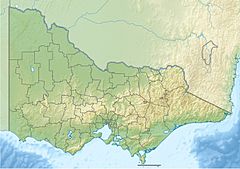Jordan River (Victoria) facts for kids
Quick facts for kids Jordan |
|
|---|---|
| Country | Australia |
| State | Victoria |
| Region | Victorian Alps (IBRA), West Gippsland |
| Local government area | Shire of Baw Baw |
| Physical characteristics | |
| Main source | Great Dividing Range near The Springs, south of Woods Point 1,170 m (3,840 ft) 37°36′0″S 146°9′36″E / 37.60000°S 146.16000°E |
| River mouth | confluence with the Thomson River Thomson Reservoir 441 m (1,447 ft) 37°42′14″S 146°19′32″E / 37.70389°S 146.32556°E |
| Length | 22 km (14 mi) |
| Basin features | |
| River system | West Gippsland catchment |
| Reservoir and lakes | Thomson Reservoir |
The Jordan River is a river in the Victorian Alps region of Victoria, Australia. It flows all year round. This river is part of the West Gippsland river system.
Contents
Where the Jordan River Flows
The Jordan River starts high up in the mountains. Its source is near a place called The Springs, south of Woods Point. This area is part of the Great Dividing Range.
The river's beginning is in the Big River State Forest. It flows mostly southeast. Much of its journey is through the Thomson State Forest. The Jordan River then joins the Thomson River. This meeting point is inside the northern part of the Thomson Reservoir.
The river drops about 732 meters (2,402 feet) along its 22-kilometer (14-mile) path.
What the River Looks Like
The Victorian Department of Primary Industries describes the Jordan River. They say it is a small, clear, and fast-flowing stream. It is about 5 meters (16 feet) wide.
The river runs through steep, forested land. Its bottom is made of rock and gravel. It can be hard to reach the river. You can usually only get to it at road crossings or along forestry tracks.
History of the Jordan Valley
The Jordan Valley was a very busy place in the late 1800s and early 1900s. People came here to mine for gold. Getting supplies to the goldfields was difficult and expensive.
In 1862, some business people from Sale offered a reward. They wanted someone to find a reliable track into the Jordan goldfields. Several people tried, including Thomas McEvoy, Fred Porter, Archie Campbell, and William Anderson.
Thomas McEvoy's track won the main prize. It became the main route for most carters and miners.
Historical Sites Along the River
Many places from the gold mining era are still here today. One important site is the Jordan River Diversion Tunnel. These historical spots are listed in the Victorian Heritage Inventory. This means they are protected because of their historical value.
Part of the Australian Alps Walking Track follows the Jordan River. This section is between the Thomson Valley and Mount Shillinglaw.
Why it's Called the Jordan River
The Jordan River was named in 1861 by Owen Little. He named it after the famous biblical River Jordan. In Hebrew, "Jordan" means "descending." Owen Little chose the name because getting to the river was "a hard road to travel."
Another reason for the name comes from miners. A report in the Gippsland Times said that miners thought the tree ferns along the river looked like palm trees. This reminded them of bible pictures. That's also why a nearby goldfield was named Jericho. Jericho is known as "the city of palm trees" in the Bible (Joshua 34:3).


